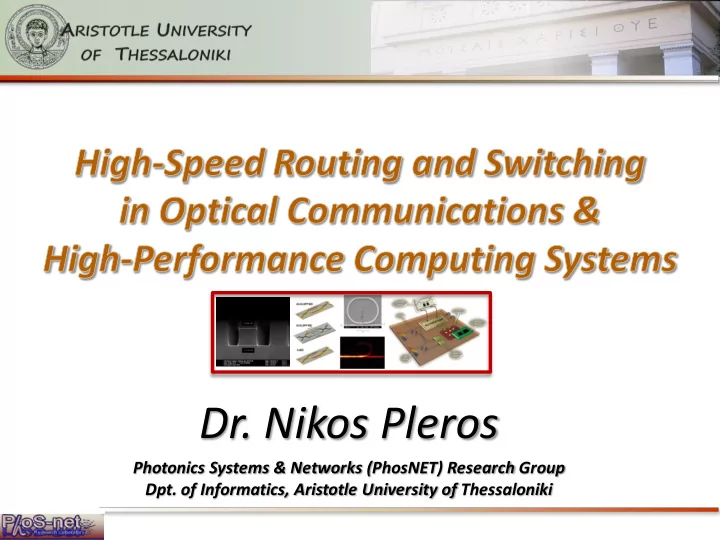

Dr. Nikos Pleros Photonics Systems & Networks (PhosNET) Research Group Dpt. of Informatics, Aristotle University of Thessaloniki
Outline HPCS systems today: status and challenges Routing in HPC systems Optics for Routing in HPC Tb/s Si-Plasmonic Routers Optical RAM
HPC examples..and metrics No.1: Jaguar (USA) No.2: Nebulae (China) 1.75 Petaflop/s 1.271 Petaflop/s ( 1 PF = 10 15 calculations per sec) Total 120640 cores 410 m 2 floor space 2.25 MW power cons. 7 MW power consumption !! relies on BladeSystem
…a look inside IBM’s Roadrunner architecture 18x Connected Units 270x Racks actually a small-range network ...with 1.04 Pflop/sec and 384 Gb/s intra-CU traffic ...and 2.5 MW power consumption !
…and here comes light in use optical fiber for the interconnection ...and enable Tb/s transmission speeds …is there any other problem ? size and cable length ultra-small latency required o for fast and low-complexity parallelization power consumption…in MWs !! o consumes what a small plant can produce !!
BladeCenters: a solution ? HPC architecture supported by IBM Blade server is a stripped down server computer, for minimizing physical space and energy requirements Blade enclosure , hosts multiple blade servers, provides power, cooling, networking, interconnects & management
BladeCenters: The vision
BladeCenters: The vision
BladeCenters: The vision
BladeCenters: The vision
BladeCenters: a solution ? creates large aggregate traffic… 100’s of Gb/s in miniature networks ! The Question: How to route this ? …in consolidated network environment …at inter -, intra-blade, backplane level without consuming most of the blade power
A new framework for photonics Wide Area Networks LANs rack-to-rack Backplane & On-chip chip-to-chip End 80’s – early 90’s …early 2000 …now Network dimensions 1000 km 1 m 1 cm 1 mm …and a new roadmap Silicon Photonics integration platform Recent example: 50Gb/s optical bus (Intel USA, 2010)
Need for chip-scale routers Shrinkit Shrinkit Shrinkit Shrinkit nodes nodes nodes nodes generic node design IC Electronic control Tb/s Optical Routing node SOI platform
Tb/s optical routers on-chip integrate plasmonics and silicon photonics platforms demonstrate integrated Tb/s routers: mm 2 footprint FP7 a few Watts power consumption 4x4 Router 2x2 Router 1.12 Tb/s throughput 560 Gb/s throughput
Plasmonics for switching Dielectric-Loaded Surface Plasmon Polaritons polymer strip (PMMA) on top of Au film PMMA-loading EM waves guided at the dielectric-gold interface small footprint (500x600nm waveguide dimensions) appropriate for interfacing photonics and electronics allows for thermooptic-induced switching phenomena low switching power consumption (few mWs) ...but high propagation losses L prop ~45 μ m (while L π ~90 μ m)
4x4 Si-Plasmonic Router Technology & Architecture 2x2 / 4x4 plasmonic IC electronic control circuit thermoopticswitches: header information processing reduce footprint & and switching matrix control power consumption SOI motherboard low loss technology hosting platform: waveguides, MUX, couplers, photodiodes, fiber coupling
Si-Plasmonic Router Multi- λ Data Δ t Header 7x λ data packets at 40Gb/s : 280 Gb/s per input port 1 extra wavelength for header (MHz data pulses) Time-offset between Header and Payload information for ensuring header processing in the IC (burst-mode network concept)
A 320Gb/s 2x2 architecture 8x40Gb/s Tx 2x2 Router DEMUX & Rx
40Gb/s NRZ 4:1 SOI MUX 4 cascaded 2 nd order silicon rings Gaps: g1=200nm (power coupling of 0.06) g2=460nm (power coupling of 0.0007) g3= 200nm (power coupling of 0.06) 100GHz R=5.4 μ m before after MUX ER >15dB λ1 λ2 λ3 λ4 40Gb/s NRZ eye
Broadband 2x2 Plasmonic Switch dual plasmonic ring resonator - R=5 μ m ~10nm 3-dB BW (1.25THz)
320Gb/s throughput routing Output 1 Output 2 ch6 ch2 ch2 ch6 6dB 5.7dB 7.5dB 8.4dB
320Gb/s throughput routing Output 1 Output 2 All channels having ER between 5.5 and 10 dB
What about buffering in HPC? Latency of the entire HPC is limited by the nsec access time of electronic RAM Processor-memory gap The well-known “Memory Wall” …but electronic RAM is the only available solution for the HPC Storage Area
Optical RAM Access Bit Bit Bit SOA SOA o/p Optical flip-flop comprises: integrated optical flip-flop as memory unit 2 ‘ O N -O FF ’ SOA switches controlled by Access Bit
Optical RAM Memory unit: Set Reset o/p recording memory content Optical flip-flop using 2 coupled optical switches Memory content = logical ‘ 1 ’ when λ1 dominant Memory content = logical ‘0’ when λ 2 dominant
5GHz Optical Random Access Read Inverted Access Bit complementary Read o/p @ λ FF#1 1556nm Read o/p @ λ FF#2 1559nm
5GHz Optical Random Access Write ‘1’ ‘0’ Inverted Access Bit Incoming Bit signal ‘0’ ‘Reset’ signal ‘0’ ‘Set’ signal No change Memory content
Towards 100GHz Optical RAM …now Optimized circuit design and silicon- integration can lead to 100GHz Read/Write RAM Speed ~ c/nL
Towards true all-optical routers
THANK YOU ! The PhosNET team… T. Alexoudi, D. Fitsios, G. Kalfas, G.T. Kanellos, A. Miliou, S. Papaioannou, D. Tsiokos , K. Vyrsokinos
Recommend
More recommend